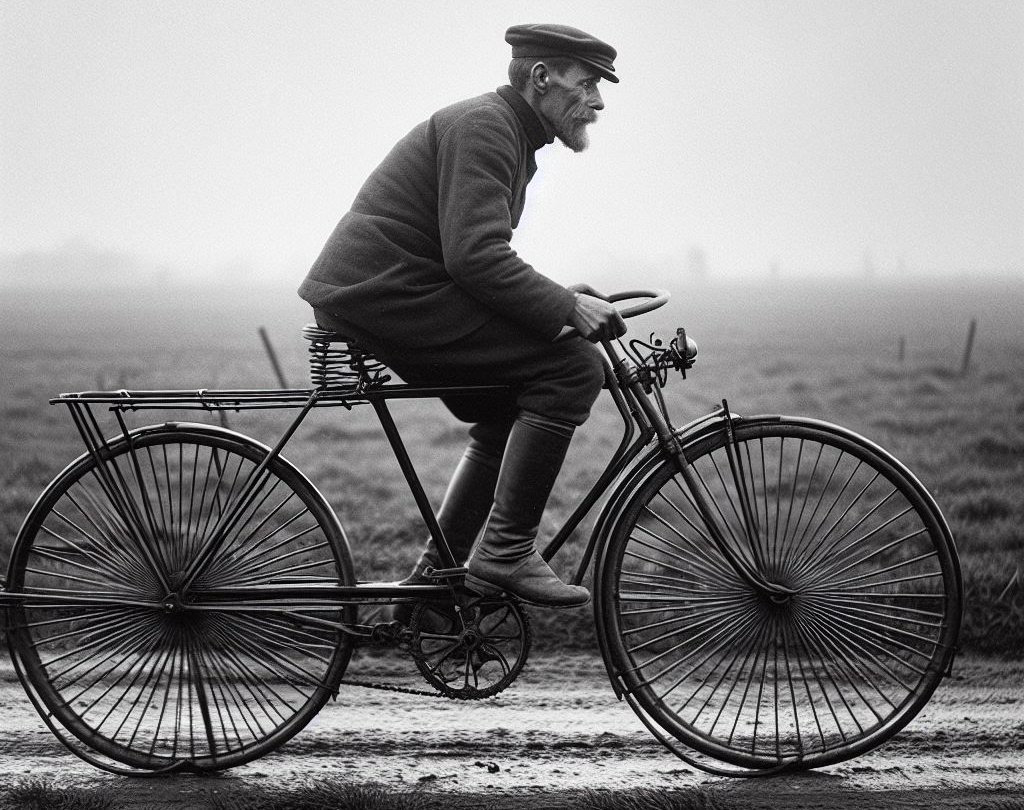Exploring The Epic Rise of The Bicycle

Learn how the bicycle has become the global phenomenon that it is today.
*This article may contain affiliate ads that help to support this site*
Over the years cycling has become one of the most popular forms of exercise and transportation in modern society, but its storied history stretches back more than two centuries. From the invention of the “running machine” aka the Velocipede in the early 19th century, to the use of bicycles in warfare during World War I, cycling has undergone significant transformations over the years. The introduction of new technologies, such as carbon fiber frames and electronic shifting, has brought cycling to new heights of performance and popularity.
Cycling is certainly now a pastime of the masses. However, the sport has also faced challenges, including controversies surrounding doping and performance-enhancing drugs. In this article, we will take a journey through the history of cycling, exploring its early origins, major milestones, and ongoing developments that have made it the beloved sport and activity it is today.
Early History Of Cycling
Did you know that the first bicycle ever invented wasn’t exactly what we would consider a bicycle today? It was called a “running machine” or “velocipede” and was basically a wooden frame with two wheels that you had to push off with your feet to get going. That’s right, no pedals! This invention was credited to Baron Karl von Drais, a German inventor who created the machine in 1817.
But it wasn’t until the mid-19th century that the pedal-driven bicycle as we know it today was developed. In 1863, Frenchman Ernest Michaux fitted pedals to the front wheel of a “boneshaker” bicycle, creating the first true bicycle. And from there, the popularity of cycling began to take off.
Just five years later, in 1868, the first bicycle race was held in France. The race was a 1,200 meter dash, and the winner was an Englishman named James Moore. But it wasn’t just racing that was becoming popular; cycling as a form of transportation was also gaining traction. It was an affordable and efficient way to get around town, and even women were beginning to ride bicycles in public.
As the popularity of cycling grew, so did the need for better roads. You can imagine cyclists being rattled to the bone with all the potholes back then. The League of American Wheelmen, founded in 1880, were early advocates for better roads and infrastructure for cyclists. By the late 1800s, cycling clubs were popping up all over the world, and long-distance cycling races were becoming a popular form of entertainment. In 1899, the first Tour de France was held, and it quickly became one of the most prestigious cycling races in the world; and it remains so til this day.
However, cycling wasn’t just a recreational activity. During World War I, bicycles were used by armies for transportation and communication. Back then, armies loved bicycles for the same reasons that we do today. It’s because bicycles gave them a tactical advantage, as they were lightweight, easy to maneuver, and could cover long distances quickly and quietly. In fact, the British army alone had over a million bicycles in service during the war.
19th and 20th Centuries
By the late 19th century, cycling had become a full-fledged craze. People everywhere were hopping on their bikes and going for long rides, often as part of cycling clubs that had sprung up around the world. These clubs were a way for like-minded cyclists to socialize, race, and advocate for better cycling infrastructure.
One of the most popular forms of long-distance cycling races during this time was the six-day race. These races were held in velodromes and involved teams of two or more riders taking turns riding around the track for six days straight! The team that covered the most distance in that time was declared the winner. These races were incredibly grueling and demanded incredible stamina and endurance from the riders.
In the mid-20th century, cycling underwent some major changes. The introduction of the derailleur gear system in the 1930s made it easier to change gears on the fly, and by the 1950s, the derailleur had become a staple of professional cycling. Now every geared bike in the world has a derailleur.
One of the biggest events in the world of cycling was established during this time…the Tour de France. The race had been founded in 1899, but it wasn’t until the mid-20th century that it really started to gain international recognition. The race was incredibly demanding, covering over 2,000 miles in just three weeks, and required incredible skill and endurance from the riders. I love to ride my bike, but that doesn’t sound like any fun to me! Someone break out the chafe cream.
In 1900, the Union Cycliste Internationale (UCI) was founded to oversee international cycling events and to promote the sport of cycling around the world. Today, the UCI is still the governing body for cycling, overseeing everything from amateur racing to professional Grand Tours.
As the 20th century continued on, cycling never stopped evolving. New technologies like carbon fiber frames and electronic shifting have made bicycles lighter, safer, faster, and more efficient than ever before. And while cycling has faced its fair share of controversies, including doping scandals and debates over the use of performance-enhancing drugs, it remains one of the most beloved sports and activities in the world.
Mid 20th Century
The mid-20th century was a time of great change for cycling. The introduction of new technologies and the rise of professional cycling brought the sport to new heights of popularity and success. Cycling went from a hobby to something you could do for a living, with sponsorships.
One of the most important events in cycling during this time was the creation of the UCI Road World Championships. The first races were held in 1921, but it wasn’t until the mid-20th century that the event really began to take off. The championships brought together the best young riders from around the world to compete for the title of world champion. The event continues to be one of the most prestigious in the sport.
The Tour de France also continued to grow in popularity during this time. The race had already established itself as one of the most challenging and demanding events in cycling, but in the mid-20th century, it also became a major media event. Millions of people around the world tuned in to watch the race each year, and the event helped to popularize cycling in countries around the world. Of course, advertisers and cycling companies were hungry to sink their teeth into something with so many eyeballs watching.
New technologies also played a major role in the evolution of cycling during this time. The introduction of lightweight aluminum frames and more advanced gearing systems made bicycles faster, lighter, and more efficient than ever before. Professional cycling teams began to experiment with new technologies and training methods, pushing the limits of what was possible in the sport.
But cycling wasn’t just about racing and competition. The mid-20th century also saw the rise of cycling as a form of transportation and recreation. I think this is where cycling really has come into its own.
People around the world began to use bicycles as a way to get around town, to commute to work, and to explore their surroundings. Just like today there were sky high gas prices in the 1970s and people sought alternative forms of transportation to their car. Cycling clubs and groups continued to flourish, offering cyclists a way to socialize and connect with other like-minded individuals.
Despite the many changes that cycling underwent during the mid-20th century, the sport remained true to its roots. People continued to flock to cycling because it offered an affordable way to get fit, get outside, connect with others, and experience the world on two wheels.

Hide A Bike Kit
Is your garage starting to become a mess? Save space by storing your bikes flat against the ceiling.
Modern Era
The biggest change in cycling in the modern era has been the continuous improvement of technology. Bicycles have become much lighter, faster, and more efficient thanks to advancements in materials and design. Electronic shifting systems, carbon fiber frames, and other high-tech components have made cycling accessible to riders of all levels and abilities.
Another major development in modern cycling has been the growth of the sport on a global scale. The popularity of cycling has exploded in recent years, with more and more people taking up the sport as a way to stay active, explore their surroundings, and connect with others. Cycling events, from local charity rides to international racing events have become bigger and more popular than ever before.
One of the most promising changes about the sport is that it has also become more inclusive and diverse. More women, people of color, and people from all walks of life taking up cycling. This has led to a greater focus on creating safe spaces and infrastructure for all cyclists, as well as a renewed emphasis on promoting cycling as a healthy and sustainable mode of transportation.
But perhaps the most exciting development in modern cycling has been the rise of e-bikes. Electric bicycles have completely revolutionized the sport, offering riders of all ages and abilities a way to enjoy the benefits of cycling without the physical strain. E-bikes have made it possible for people who might not have been able to ride a traditional bike to experience the joys of cycling, and have opened up new opportunities for commuting and exploring. I think the biggest beneficiaries are people who have cycled their whole lives but can no longer ride a normal bike uphill. An e-bike offers them the perfect solution to stay on the road!
Future Of Cycling: Next 20 Years
What does the future hold for cycling? E-bikes have already transformed the cycling landscape, and their popularity is only going to grow in the coming years. As battery technology continues to improve, e-bikes will become more efficient, more affordable, and more versatile. We can expect to see a wider range of e-bike styles and designs, including more powerful and long-range models that can handle challenging terrain and longer distances. I for one, can’t wait to see what comes out in the upcoming years. Personally, I think we will start to see more high powered bicycle/moped hybrids.
Governments and municipalities around the world are recognizing the many benefits of cycling, from reducing traffic congestion to improving public health. As a result, we can hope to see continued investment in cycling infrastructure, including more bike lanes, bike parking facilities, and other amenities that make cycling safer and more convenient.
Everything seems like it is getting smarter these days, and bike tech is no exception. From smart helmets that can detect crashes and call for help to bike-sharing programs that use AI to optimize bike placement and maintenance, smart technology is already transforming the world of cycling. In the coming years, we can expect to see even more innovations that make cycling safer, more efficient, and more enjoyable, such as smart bike locks, real-time route planning, and advanced bike lighting systems.
Indoor cycling has always been popular, however the COVID-19 pandemic has accelerated the trend toward virtual cycling, as more and more people are turning to indoor cycling platforms like Zwift and Peloton to stay active and connected. As virtual cycling technology continues to improve, we can expect to see more immersive and interactive experiences that blur the line between the real world and the digital realm. Just imagine smelling fresh dew as you pedal away in your basement on your Peloton.
Cycling has always been a social and cultural activity, and that’s not likely to change anytime soon. In the coming years, we can expect to see a greater emphasis on diversity, equity, and inclusion in the cycling community, as well as a renewed focus on sustainability and environmental stewardship. We can also expect to see new forms of cycling culture emerge, such as bikepacking, gravel racing, and other adventurous forms of cycling that push the boundaries of what’s possible on two wheels.

Hide-A-Bike Installation Guide
If you want to put together a Hide-A-Bike kit for yourself, just download these easy to follow, step-by-step directions, complete with a full hardware and parts list.
Conclusion
The history of cycling is a rich and fascinating story, filled with innovation, competition, and adventure. From the early days of the hobbyhorse to the modern era of high-tech bikes and cutting-edge racing, cycling has only grown in popularity through the years. And I expect it will continue to do so in the future. Looking ahead, we can expect to see even more exciting developments from advancements in e-bikes and smart technology to continued investment in cycling infrastructure and a renewed focus on sustainability and inclusivity. One thing is for sure, the steady rise of cycling is never going to slow down. It’s just too darn fun!
Share This Article With A Friend
Did You Read This Whole Article?

You deserve a gift! Enter your email to receive a FREE copy of the Hide-A-Bike Installation Guide! And once a month we will send you a newsletter with the best deals on the internet for bicycle gear and accessories.
About Hide A Bike

Save space by keeping your bike flat against the ceiling with the original easy and convenient bicycle storage solution.
Thank You For Visiting!

You deserve a gift! Enter your email to receive a FREE copy of the Hide-A-Bike Installation guide. And once a month we will send you a newsletter with links to our best finds on bicycle gear and accessories.
Share This Article:
Most Popular Articles:
Article Categories:
Related Articles:

History Of The Bicycle: From Craftsmanship To Mass Production

A Century of Cycling: Innovations In Bicycle Technology





